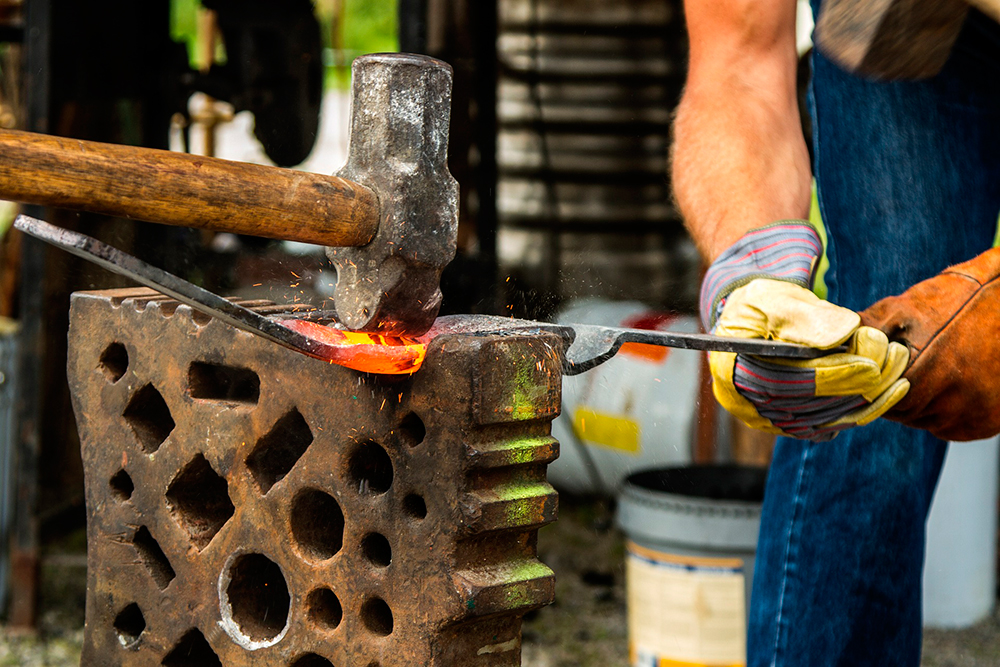
Gerry Drew forges his knives the old-school way. Photos by Tim Robison.
As the son of a logger in Northern Minnesota, Gerry Drew was raised in the woods with a knife at his side. Though this anecdote would be the most obvious and, well, idyllic dawn of a 25-year bladesmithing hobby, the self-titled “curmudgeon” insists that it all began sooner. Drew’s knack for shaping knives from hunks of steel began when his family frequented caves and smashed rocks into rudimentary tools. It was less American Dream-like and more barbaric, he says.
Now, years or perhaps epochs later, this “well-groomed mountain man” is hammering out tomahawks, camp axes, and drop-point blades down in Tryon.
Six days per week, he works out of a backyard garage-turned-studio outfitted with a gas forge, four rust-laden anvils, 23 hammers, and various sanders. At the front of the space sits a gnarly-looking power hammer: a mechanized slight in the centuries-old practice.

Despite the gritty, soot-covered setup, there was a time when Drew failed to appreciate the rather laborious, but traditional, art of blacksmithing. Even as a youngster, his father, a notable woodsman with a foundation in automotive repair, had never once forged.
“We knew blacksmiths, of course,” he says. “But it was a dying craft.”
It wasn’t until 2009, when Drew took a “Beginning Blacksmithing” class at the Tryon School of Arts and Crafts, that his handiwork began to evolve. Up until then, he had devoutly relied on the stock removal method, which involves starting with a flat piece of steel and grinding off the excess until it takes the appropriate form.
Circa 1990, before trying his hand in the “smithy,” Drew also picked up a few sloppy habits from a library book. Using the how-to hardback — a “bad, bad source,” he says — he began grinding down files and old saw blades. Out of hours of trial and error came his first camping knife – an “ugly mess” of a thing.
“The other day, I found it in a knapsack in the attic,” Drew says. “I had to look over my shoulder to make sure no one saw it.”
Still, he kept at it, getting a bit of help from “scores of people” and Internet forums. From there, after sweating over the Tryon School’s coal forge and retiring from industrial product sales, the grandfather of 11 began melding his own brand and style.
Drew now touts the slogan, “Hunting Knives Made by a Knifemaker that Hunts,” a nod to his many decades of tracking elk, caribou, and bear across North America. His pieces, ranging from ulus to tomahawks, are unembellished minus a small anvil-like trademark carefully etched near the knife’s handle.
“They’re plain, usable, and pleasing to the eye,” Drew adds. “It’s just a basic tool.”
Though he considers the practice more of a craft than an art, there’s still room for creativity. In fact, he abandoned the stock removal method because of the flexibility that comes with blacksmithing. After heating a flat piece of steel — a knifemaker’s blend from New Jersey and the 70-pound bane of the postal carrier’s existence — Drew begins hammering.
“It’s red-hot and plastic,” he says. “This way, you can put turns, bends, and curves in the knife.”
After being sanded, the metal undergoes a heat-treating and tempering process to ensure that the steel is neither too hard nor too soft. Then, things get delicate, says Drew.
Using a belt sander, he cleans up his work, making it “shiny and attractive.” The handle, often made of fiddleback maple or knotty sycamore outsourced from a neighbor’s woodpile, is attached last. Eventually, the whole thing is shipped up to Iowa, where the wood is waterproofed with resin.
Drew has yet to total up the number of man-hours he puts into a single $80 to $300 knife — because if he did, he says he would “probably just take up knitting.” For him, forging is not a career, even though long shop hours suggest it’s way more than a hobby.
Out of his own “curmudgeonly stubbornness,” the Minnesota native stopped taking special orders years ago. Instead, he makes the knives how he wants to, and hopes that someone, perhaps a former Cub Scout or an avid collector, will be pleased.
“My biggest joy is watching guys just gravitate toward my knives,” he says, nearly beaming. “Most grew up carrying a pocket knife at all times.”
Drew, that rough-and-tumble logger’s son, is no exception. Vying for cellphone service atop a knoll near a family hunting shack in Indiana, he is clad with a multi-purpose knife and drop-point hunter. In the neighboring woods, hounds chase does as his three sons roam with their own children, using camp axes forged by their father’s hands to cut pine saplings and oak snags.
“Whenever my grandchildren come over, they want to forge,” he says. “And whenever they’re in the woods, they carry one of my knives.”
Here, where craftsmanship is being passed down the bloodline, is perhaps the most obvious ending, for the time being at least.
Gerry Drew will be spending part of his summer forging new frontiers in the Yukon, although when in Tryon he periodically teaches local classes. For more information, contact him at gldrewknives@gmail.com



Great Article. I know Gerry Drew very well and admire his many talents and his desire to share with others.